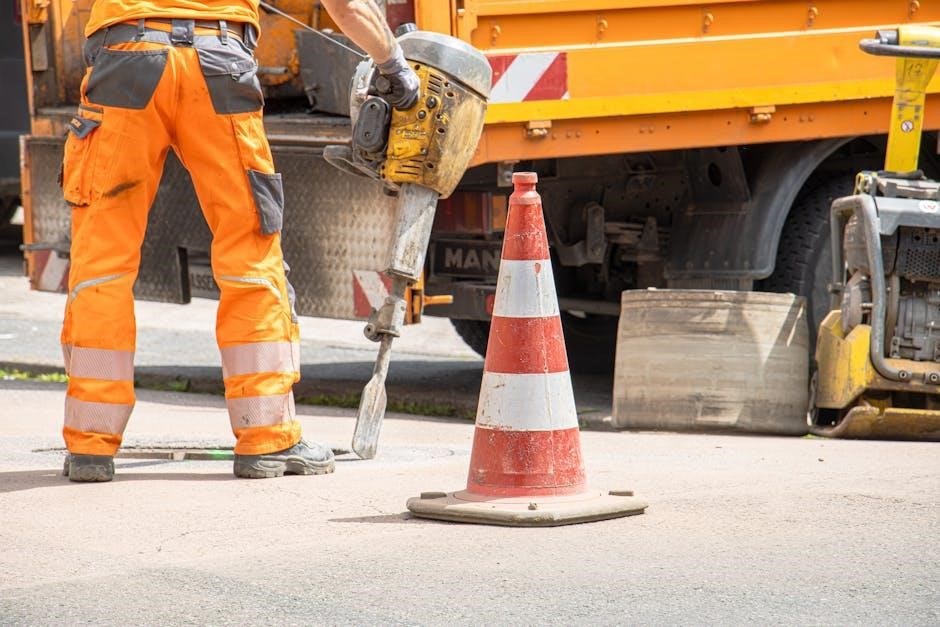TxDOT manuals are essential resources for Texas transportation projects, providing guidelines and best practices for pavement, construction, traffic, and environmental compliance․ They ensure safety and efficiency in infrastructure development․
1․1 Overview of TxDOT Manuals
TxDOT manuals provide comprehensive guidelines for transportation projects in Texas, covering various aspects such as pavement management, construction, traffic control, and environmental compliance․ These manuals are designed to ensure adherence to safety standards, best practices, and regulatory requirements․ They serve as vital resources for engineers, contractors, and project managers, offering detailed procedures and specifications for infrastructure development․ The manuals are regularly updated to reflect advancements in technology and changes in regulations․ They cover topics ranging from pavement condition assessments to material specifications and traffic signal maintenance․ By following these manuals, stakeholders can ensure the delivery of high-quality, durable, and sustainable transportation systems across Texas․
1․2 Importance of TxDOT Manuals in Transportation Projects
TxDOT manuals are crucial for ensuring the effective management and execution of transportation projects in Texas․ They provide standardized guidelines that promote consistency, safety, and compliance with regulatory requirements․ By adhering to these manuals, professionals can deliver projects that meet high-quality standards, reducing risks and enhancing public safety․ The manuals also serve as a reference for best practices, helping to minimize costs and extend the lifespan of infrastructure․ Additionally, they facilitate collaboration among stakeholders by providing clear expectations and procedures․ Overall, TxDOT manuals are indispensable for maintaining the integrity and efficiency of Texas’s transportation network, ensuring that projects are completed effectively and sustainably․

Pavement Management Manuals
TxDOT Pavement Management Manuals provide essential guidelines for assessing, maintaining, and rehabilitating pavements, ensuring durability and safety in Texas roadways through standardized practices and updated methodologies․

2․1 TxDOT Pavement Manual
The TxDOT Pavement Manual provides comprehensive guidelines for pavement design, construction, and maintenance․ It covers materials, testing procedures, and best practices for asphalt and concrete pavements․ The manual emphasizes the importance of proper pavement management to extend roadway life and ensure safety․ Key topics include pavement condition assessment, rehabilitation techniques, and the use of advanced materials like fuel-resistant asphalt binders․ It also details temperature ranges for asphalt mixtures, such as 330°F, to ensure optimal performance․ By adhering to these standards, engineers can deliver durable and efficient transportation infrastructure․ The manual is regularly updated to reflect the latest industry advancements and is accessible online for easy reference․
2․2 Pavement Condition Assessment Guidelines
The Pavement Condition Assessment Guidelines provide detailed methodologies for evaluating pavement performance and identifying maintenance needs․ These guidelines emphasize visual inspections, non-destructive testing, and advanced technologies like temperature cameras to monitor pavement health․ They outline criteria for rating pavement distresses, such as cracking, rutting, and surface degradation․ Regular assessments help prioritize repairs, prevent premature deterioration, and optimize resource allocation․ The guidelines also stress the importance of documenting findings to support long-term pavement management strategies․ By following these protocols, engineers can ensure pavements remain safe, durable, and functional, aligning with TxDOT’s goals for efficient transportation infrastructure․ These assessments are crucial for maintaining Texas roadways’ integrity and user safety․

Construction and Materials Manuals
TxDOT’s Construction and Materials Manuals outline standards, specifications, and best practices for road construction, ensuring compliance with safety and quality requirements․ They cover materials like asphalt binders and aggregates․
3․1 TxDOT Construction Manual
The TxDOT Construction Manual provides detailed guidelines for constructing transportation infrastructure, from earthwork to final paving․ It includes specifications for materials, safety protocols, and environmental considerations to ensure projects meet state standards and are completed efficiently; The manual is regularly updated to reflect advancements in technology and best practices, making it a critical resource for contractors and engineers․ By adhering to its guidelines, stakeholders can ensure compliance with regulatory requirements and deliver high-quality infrastructure projects across Texas․
3․2 Material Specifications for Road Construction
Material specifications for road construction outlined in TxDOT manuals ensure the use of high-quality, durable materials․ These specifications detail requirements for aggregates, asphalt binders, concrete, and other components․ They also cover testing procedures to verify material compliance with state standards․ Adherence to these guidelines ensures that roads are built to last, resisting wear from traffic and environmental factors․ The manuals provide clear criteria for selecting and approving materials, fostering consistency across projects․ By following these specifications, contractors can deliver infrastructure that meets safety and performance expectations, reducing maintenance needs over time․ Regular updates to the specifications reflect advancements in material science and construction technologies․
Traffic and Roadway Manuals
TxDOT’s traffic and roadway manuals provide guidelines for safe and efficient road systems, including traffic control devices, signage, and roadway design standards to enhance mobility and safety․
4․1 Traffic Control Devices Manual
The Traffic Control Devices Manual outlines standards for installing, maintaining, and operating traffic control devices to ensure safety and efficiency on Texas roadways․ It covers signage, signals, and markings, ensuring compliance with federal and state regulations․ The manual provides detailed guidelines for various traffic scenarios, including construction zones and pedestrian crossings․ TxDOT updates the manual periodically to reflect best practices and technological advancements․ Proper implementation of these guidelines helps reduce accidents and enhances traffic flow․ The manual serves as a critical resource for engineers, contractors, and maintenance crews, ensuring uniformity in traffic control across the state․ Adherence to these standards is essential for public safety and efficient transportation systems․
4․2 Roadway Design Standards and Guidelines
The Roadway Design Standards and Guidelines provide detailed criteria for designing safe and efficient roadways in Texas․ These standards cover geometric design elements such as alignment, cross-section, and intersections, ensuring consistency across all projects․ They also address drainage, materials, and environmental considerations to promote durability and sustainability․ The guidelines are updated regularly to incorporate advancements in engineering and safety practices․ By adhering to these standards, engineers and designers can create roadways that minimize accidents, accommodate traffic demands, and integrate seamlessly with existing infrastructure․ Compliance with these guidelines is critical for ensuring public safety and maintaining the integrity of Texas’s transportation network․

Bridge and Structures Manuals
TxDOT’s Bridge and Structures Manuals provide critical guidelines for designing, inspecting, and maintaining bridges and structural components․ They ensure safety, durability, and compliance with engineering standards․
5․1 TxDOT Bridge Inspection Manual
The TxDOT Bridge Inspection Manual offers detailed procedures for evaluating bridge structures, ensuring safety, and extending service life․ It covers inspection techniques, documentation, and repair recommendations, adhering to federal guidelines․
5․2 Structural Design Criteria for Bridges
The Structural Design Criteria for Bridges provide standardized engineering guidelines for designing safe and durable bridge structures in Texas․ These criteria ensure compliance with federal regulations and industry standards․ They cover load calculations, material specifications, and safety factors to withstand various stresses, including dead loads, live loads, wind, and seismic activity․ The criteria emphasize the use of advanced design methodologies, such as the load and resistance factor design (LRFD) approach․ Material requirements for concrete, steel, and other components are detailed to ensure structural integrity․ Regular updates reflect advancements in engineering practices and evolving transportation needs, ensuring bridges are built to last and meet public safety expectations․
Environmental Compliance Manuals
TxDOT Environmental Compliance Manuals outline guidelines for assessing and mitigating environmental impacts during transportation projects, ensuring adherence to federal and state regulations for sustainable development and resource protection․
6․1 Environmental Impact Assessment Guidelines
The Environmental Impact Assessment (EIA) Guidelines within TxDOT manuals provide a framework for evaluating the potential environmental effects of transportation projects․ These guidelines ensure compliance with federal and state regulations, promoting sustainable development․ They outline procedures for conducting thorough assessments, including data collection, analysis, and public participation․ The EIA process helps identify mitigation measures to minimize adverse impacts on ecosystems, air quality, noise levels, and cultural resources․ By adhering to these guidelines, TxDOT ensures that projects are environmentally responsible and align with long-term sustainability goals․ The guidelines also emphasize the importance of transparent documentation and stakeholder engagement throughout the assessment process․
6․2 Stormwater Management Regulations
TxDOT’s Stormwater Management Regulations outline requirements for controlling and managing stormwater runoff during construction and post-construction activities․ These regulations aim to prevent pollution and protect water quality by implementing best management practices (BMPs)․ They cover erosion control measures, sedimentation basins, and permeable pavements․ The guidelines ensure compliance with the Clean Water Act and state laws, emphasizing the importance of proper planning and maintenance․ By adhering to these regulations, TxDOT promotes environmentally responsible practices, reducing the risk of water contamination and maintaining ecological balance․ Regular inspections and adherence to these standards are crucial for sustainable stormwater management in transportation projects․
Project Development Manuals
Project Development Manuals provide comprehensive guides for planning, designing, and delivering transportation projects․ They ensure compliance with regulations, technical standards, and best practices to guarantee safety and efficiency․ These manuals cover feasibility studies, environmental assessments, and construction planning, offering a structured approach for TxDOT teams to follow․ By adhering to these guidelines, engineers and contractors can ensure projects meet public needs and comply with state and federal requirements․ The manuals also foster collaboration among stakeholders, ensuring successful project outcomes․
7․1 Project Development Process Overview
The Project Development Process Overview outlines the stages involved in delivering transportation projects, from initial planning to final delivery․ It ensures adherence to TxDOT standards and federal regulations, promoting safety and efficiency․ The process includes feasibility studies, environmental assessments, and public engagement to address community needs․ Detailed design phases and construction planning are also covered, emphasizing collaboration between engineers, contractors, and stakeholders․ By following this structured approach, teams can manage risks, optimize resources, and deliver projects that meet public expectations․ The manual also provides tools for monitoring progress and ensuring compliance, fostering transparency and accountability throughout the development lifecycle․

7․2 Design and Construction Project Delivery Methods
TxDOT’s Design and Construction Project Delivery Methods guide outlines various approaches for executing projects efficiently․ These methods include traditional design-bid-build, design-build, and public-private partnerships․ Each method is tailored to specific project requirements, ensuring cost-effectiveness and timely delivery․ The manual emphasizes the importance of clear communication and collaboration between designers and contractors․ It also covers risk management strategies and quality control measures to maintain high standards․ By leveraging these delivery methods, TxDOT aims to enhance project outcomes while minimizing disruptions to the public․ The guidelines provide a framework for selecting the most suitable approach based on project complexity, budget, and community impact, ensuring optimal results for Texas’s transportation infrastructure․
Maintenance and Operations Manuals
TxDOT’s maintenance and operations manuals provide detailed guidelines for road and traffic signal upkeep, ensuring safety and efficiency in preserving Texas’s transportation infrastructure․
8․1 Road Maintenance Best Practices
TxDOT’s road maintenance best practices emphasize proactive strategies to extend pavement life and ensure safety․ Regular inspections, timely repairs, and cost-effective treatments are prioritized․ Crack sealing, surface overlays, and joint repairs are common methods․ Seasonal maintenance, such as winter preparedness and vegetation control, is also critical․ Using durable materials and advanced technologies enhances efficiency․ Safety compliance and environmental considerations are integrated into all practices to minimize disruptions and protect natural resources․ These guidelines help maintain Texas’s vast road network, ensuring smooth and safe travel for all users while optimizing public funds․
8․2 Traffic Signal Maintenance Guidelines
TxDOT’s traffic signal maintenance guidelines ensure optimal functionality and safety․ Regular inspections, including visual checks and diagnostic testing, are crucial to identify and repair issues promptly․ Technicians must follow specific protocols for replacing defective components, such as signal heads, controllers, and sensors․ Seasonal adjustments, like verifying signal timing during daylight-saving changes, are essential․ Proper documentation of maintenance activities is required to track performance and plan future upkeep․ Adherence to safety standards, such as de-energizing signals before work, prevents accidents․ Additionally, upgrading to energy-efficient technologies and implementing smart traffic systems enhances operations․ These guidelines help maintain reliable traffic flow, reducing congestion and improving public safety across Texas roadways․
Geotechnical Manuals
TxDOT’s geotechnical manuals provide criteria for soil and rock analysis, ensuring structural integrity in transportation projects․ They guide subsurface investigations and ground condition evaluations, aligning with engineering standards․
9․1 Geotechnical Engineering Guidelines
The TxDOT Geotechnical Engineering Guidelines outline procedures for soil mechanics, rock mechanics, and foundation engineering․ These guidelines ensure that transportation infrastructure is built on stable ground, minimizing risks․ They cover soil classification, bearing capacity calculations, and pile foundation designs․ The manuals emphasize subsurface investigations to determine soil properties and groundwater levels․ Engineers use these guidelines to select appropriate materials and construction methods․ Compliance with these standards ensures that bridges, roads, and other structures meet safety and durability requirements․ Regular updates incorporate advancements in geotechnical engineering, reflecting best practices and new technologies․ Adhering to these guidelines is critical for preventing structural failures and ensuring long-term performance of transportation projects across Texas;
9․2 Subsurface Investigation Requirements
TxDOT’s subsurface investigation requirements ensure thorough site assessments for transportation projects․ These investigations involve soil borings, cone penetration tests (CPT), and geophysical methods to gather detailed subsurface data․ The guidelines emphasize accurate determination of soil properties, groundwater levels, and rock characteristics․ Engineers use this data to assess soil stability, foundation design, and potential settlement risks․ Proper subsurface investigations are critical for preventing structural issues and ensuring long-term safety․ The manuals outline specific sampling frequencies, testing protocols, and documentation standards․ By adhering to these requirements, TxDOT ensures that all projects are built on a solid foundation, minimizing risks and enhancing infrastructure durability across Texas․

Right of Way and Utilities Manuals
TxDOT’s Right of Way and Utilities Manuals provide guidelines for acquiring land, relocating utilities, and ensuring compliance with state laws during transportation projects, minimizing disruptions․
10․1 Right of Way Acquisition Process
The Right of Way (ROW) acquisition process, as outlined in TxDOT manuals, ensures landowners’ rights are protected while securing necessary property for transportation projects․ It involves appraisal, negotiation, and condemnation if required․ The process begins with identifying the needed property and conducting a detailed appraisal to determine fair market value․ Negotiations with landowners follow, aiming for voluntary agreements․ If agreements cannot be reached, legal proceedings may be initiated to acquire the land through eminent domain․ Throughout the process, TxDOT adheres to federal and state regulations to ensure fairness and transparency․ This systematic approach helps balance project needs with landowner interests, maintaining public trust and compliance with legal standards․

10․2 Utility Relocation Guidelines
TxDOT manuals provide comprehensive guidelines for utility relocation, ensuring minimal disruption during transportation projects․ The process involves coordination between utility owners, contractors, and TxDOT to plan and execute relocations efficiently․ Utilities must be relocated before construction begins, with costs typically borne by the utility provider․ Permits and approvals are required, and all work must comply with TxDOT standards and safety regulations․ Detailed designs and schedules are submitted for review to ensure alignment with project timelines․ Communication and collaboration are critical to avoid delays and maintain service continuity․ These guidelines help balance project execution with the need to preserve essential services, ensuring public convenience and infrastructure integrity throughout the process․

Hydraulic and Drainage Manuals
TxDOT’s hydraulic and drainage manuals provide essential guidelines for designing and managing drainage systems, ensuring safe and efficient water management in transportation infrastructure across Texas․
11․1 Hydraulic Design Criteria
The Hydraulic Design Criteria provided by TxDOT manuals outline the essential standards for designing drainage systems, ensuring efficient water management in transportation infrastructure․ These criteria cover key aspects such as design parameters, drainage area classifications, and rainfall intensity calculations․ They also address runoff coefficients, time of concentration, and peak flow rates to ensure proper system sizing․ The guidelines emphasize the importance of hydrologic and hydraulic analyses to maintain water quality and prevent flooding․ Specific design considerations for inlets, storm sewers, and culverts are included to ensure compliance with TxDOT standards․ Regular updates to these criteria reflect advancements in engineering practices and regulatory requirements, making them a reliable resource for engineers and planners․
11․2 Stormwater Drainage System Design
The TxDOT manuals provide comprehensive guidelines for designing stormwater drainage systems, ensuring effective water management and compliance with environmental regulations․ Designers must consider factors such as watershed characteristics, rainfall intensity, and runoff patterns to determine system capacity․ The manuals outline best practices for inlet and outlet design, storm sewer sizing, and culvert placement․ They also emphasize the importance of maintaining water quality through detention ponds and erosion control measures․ Proper material selection and installation techniques are detailed to ensure system durability․ These guidelines help engineers design systems that safely convey stormwater while minimizing environmental impact and ensuring public safety․ Adherence to these criteria is essential for reliable and sustainable drainage solutions․

Accessing TxDOT Manuals
TxDOT manuals are accessible online at TxDOT’s official website, providing updated resources for transportation professionals․ Regularly check for revised versions to ensure compliance and best practices․
12․1 Online Resources for TxDOT Manuals
TxDOT manuals are readily available online through the official TxDOT website at TxDOT Manuals․ The portal provides easy access to a comprehensive library of documents, including the Pavement Manual, Construction Manual, and Traffic Control Devices Manual․ Users can search by topic or browse categories such as pavement management, construction, and environmental compliance․ The online platform ensures that professionals have access to the latest guidelines, specifications, and best practices․ Additionally, supplementary materials like forms, checklists, and training resources are often included․ These resources are free and open to the public, making them an invaluable tool for engineers, contractors, and transportation professionals across Texas․ Regular updates are posted, so users are encouraged to check back for revised editions and new publications․
12․2 Updated Versions and Revisions
TxDOT manuals are regularly updated to reflect the latest advancements in transportation engineering and compliance standards․ Revisions are typically released quarterly, with notifications provided through the official TxDOT website․ Professionals are encouraged to subscribe to electronic notifications to stay informed about new editions․ Recent updates include revisions to the Pavement Manual and Traffic Control Devices Manual, incorporating new materials and technologies․ These updates ensure that practitioners have access to the most current guidelines, specifications, and best practices․ The revision process is transparent, with summaries of changes published alongside updated documents․ Staying updated is crucial for compliance and effective project execution, as outdated manual references may lead to non-compliance or suboptimal outcomes in transportation projects․
